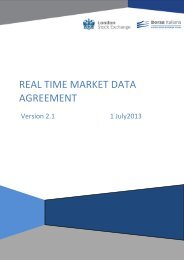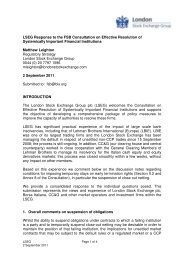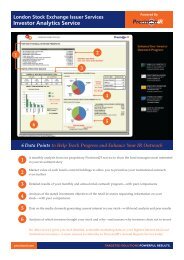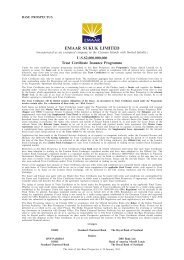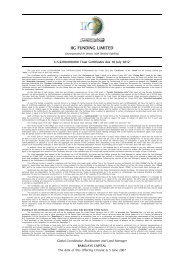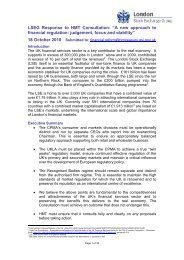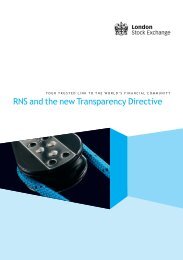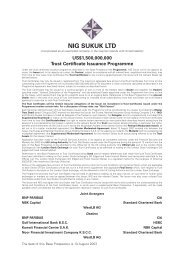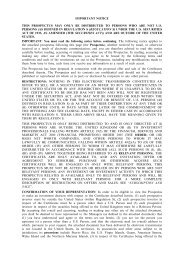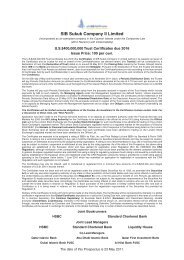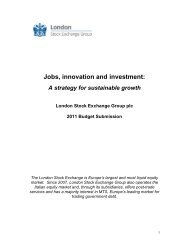Tabreed 06 Prospectus - London Stock Exchange
Tabreed 06 Prospectus - London Stock Exchange
Tabreed 06 Prospectus - London Stock Exchange
You also want an ePaper? Increase the reach of your titles
YUMPU automatically turns print PDFs into web optimized ePapers that Google loves.
NATIONAL CENTRAL COOLING COMPANY (PJSC)<br />
NOTES TO THE CONSOLIDATED FINANCIAL STATEMENTS<br />
31 December 2004<br />
2 SIGNIFICANT ACCOUNTING POLICIES continued<br />
Leases where the lessor effectively retains substantially all the risks and benefits of ownership of the<br />
leased item are classified as operating leases. Operating lease payments are recognised as an expense<br />
in the income statement on a straight line basis over the lease term.<br />
Employees’ end of service benefits<br />
The Company and its subsidiaries provide end of service benefits to its expatriate employees. The<br />
entitlement to these benefits is based upon the employees’ final salary and length of service, subject to<br />
the completion of a minimum service period. The expected costs of these benefits are accrued over the<br />
period of employment.<br />
With respect to its national employees, the Company and its subsidiaries make contributions to the<br />
relevant UAE Government pension scheme calculated as a percentage of the employees’ salaries. The<br />
obligations under these schemes are limited to these contributions, which are expensed when due.<br />
Derivative financial instruments<br />
The Company uses derivative financial instruments such as interest rate swaps and caps to hedge its<br />
risks associated with interest rate currency fluctuations. Such derivative financial instruments are<br />
stated at fair value. The fair value of interest rate swap and cap contracts is determined by reference<br />
to market values for similar instruments. Derivatives with positive market values (unrealised gains)<br />
are included in other assets and derivatives with negative market values (unrealised losses) are<br />
included in other liabilities in the balance sheet.<br />
For the purposes of hedge accounting, hedges are classified as either fair value hedges where they<br />
hedge the exposure to changes in the fair value of a recognised asset or liability; or cash flow hedges<br />
where they hedge exposure to variability in cash flows that is either attributable to a particular risk<br />
associated with a recognised asset or liability or a forecasted transaction.<br />
In relation to fair value hedges which meet the conditions for hedge accounting, any gain or loss<br />
from remeasuring the hedging instrument at fair value is recognised immediately in the income<br />
statement. Any gains or losses on the hedged item attributable to the hedged risk are adjusted against<br />
the carrying amount of the hedged item and recognised in the income statement. Where the<br />
adjustment is to the carrying amount of a hedged interest-bearing financial instrument, the adjustment<br />
is amortised to the income statement such that it is fully amortised by maturity.<br />
In relation to cash flow hedges which meet the conditions for hedge accounting, the portion of the<br />
gain or loss on the hedging instrument that is determined to be an effective hedge is recognised<br />
initially in equity and the ineffective portion is recognised in the income statement. The gain or loss<br />
on effective cash flow hedges recognised initially in equity is either transferred to the income<br />
statement in the period in which the underlying transaction impacts the income statement or<br />
capitalised with other borrowing costs directly attributable to the construction of each plant as part<br />
of the capital work in progress. The capitalisation of gain or loss ceases when the asset is<br />
commissioned for use.<br />
For derivatives that do not qualify for special hedge accounting, any gain or loss arising from<br />
changes in fair value is taken to the income statement.<br />
Hedge accounting is discontinued when the hedging instrument expires or is sold, terminated or<br />
exercised, or no longer qualifies for special hedge accounting. At that point in time, any cumulative<br />
gain or loss on the hedging instrument recognised in equity is kept in equity until the forecasted<br />
transaction occurs.<br />
Foreign currencies<br />
Transactions in foreign currencies are recorded at the rate ruling at the date of the transaction.<br />
Monetary assets and liabilities denominated in foreign currencies are retranslated at the rate of<br />
exchange ruling at the balance sheet date. All differences are taken to the income statement.<br />
F-49



